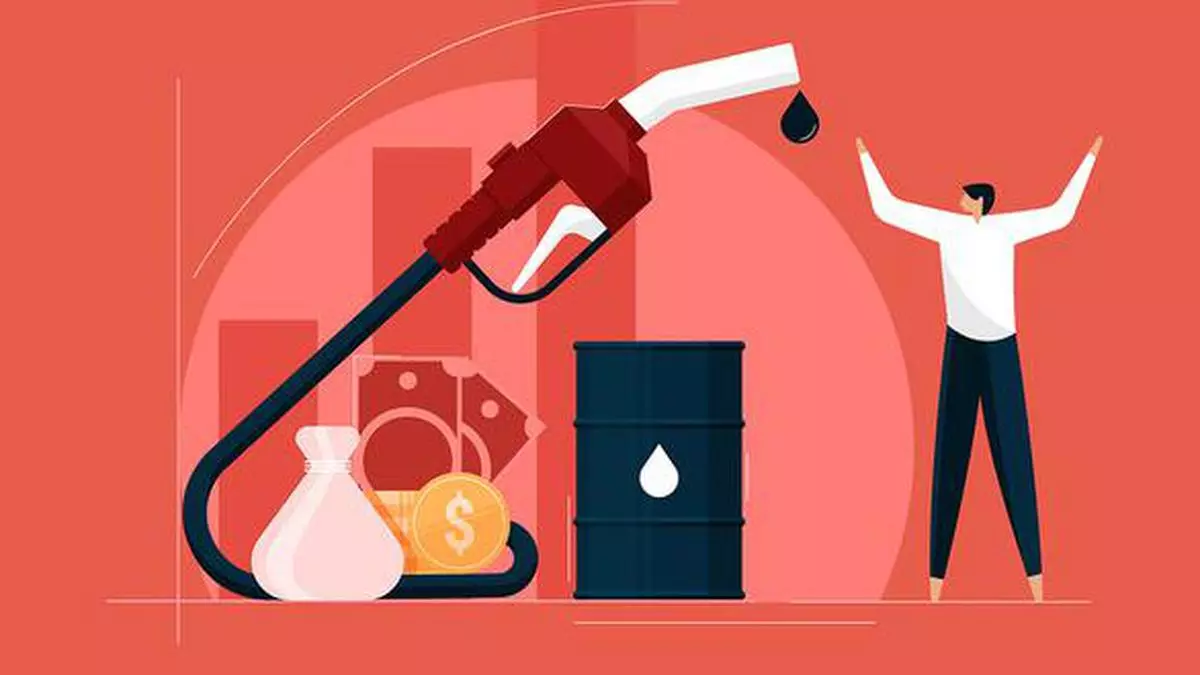Clipped from: https://www.thehindubusinessline.com/todays-paper/tp-opinion/high-oil-prices-and-their-domino-effects/article65294527.ece

Fuel and energy prices have a cascading effect, pushing up costs at every stage of production iStock uniquepixel | Photo Credit: uniquepixel
Impact on growth, inflation, Budget numbers and the BoP cannot be shrugged aside. A policy to deal with oil shocks is needed
Oil prices have always haunted the Indian economy. An adverse oil price shock tends to mess up many of India’s macroeconomic variables. Since the Russian invasion of Ukraine, oil prices have started moving to uncomfortable zones. Over the last year, Brent crude price has doubled. Even in March, there was huge volatility in oil prices. There is speculation that if the war does not de-escalate, oil prices may soon touch $140 a barrel.
Faced with such a steep upward movement of oil prices, policymakers have perhaps gone back to the drawing board to evaluate its impact — that too when the economy has just started coming out of the pandemic.
What were the oil price assumptions at the beginning of the year? In its January 2022 update of World Economic Outlook, the IMF assumed oil prices to be $77.31 in 2022 and $71.29 in 2023. In India, a key assumption behind the projected GDP growth in the Economic Survey 2021-22 was that oil prices would be $70-75/barrel. With all such assumptions going haywire, where is the Indian economy headed?
Cascading effect
The most obvious impact of high oil prices in India is on inflation. Domestic fuel prices are going up. There has been a steep hike of Rs. 25/litre in bulk diesel prices, and petrol, diesel and LPG prices are steadily moving up. This will have a direct impact on inflation. ‘Fuel and power’ have 13.20 per cent weightage in the Wholesale Price Index (WPI), and ‘fuel and light’ have 6.8 per cent weight in the Consumer Price Index (CPI).
Moreover, fuel and energy costs have a cascading effect on prices as they push up cost at every stage of production.
Recent unofficial estimates suggest that in an optimistic scenario of international oil prices at $100/barrel, domestic inflation is likely to go up by 52-65 basis points (bps). In October 2021, the RBI estimated that a 10 per cent increase in crude oil prices can push up domestic inflation by 30 bps.
Worse, this increase in oil prices comes in the backdrop of already high inflation rates. While the CPI inflation in February stood at 6.07 per cent, the WPI inflation was at a much higher 13.11 per cent. The divergence between CPI and WPI inflation is possibly an indicator that the CPI inflation will be on its way up in the coming months.
To control the rising inflation, the government can absorb some of the increase in international crude prices by reducing taxes on petrol and diesel. But this can have a negative impact on tax collection.
The Russia-Ukraine war and the increase in gas prices have also pushed up domestic prices of urea and potash. This threatens to increase the fertiliser subsidy bill of the government by about Rs. 10,000 crore. The government will have to rework its budget to accommodate these cost escalations.
The increase in oil prices and the recent geopolitical turmoil are also likely to hurt India’s GDP growth. Recent estimates have revised India’s growth rate for 2021-22 and 2022-23 downwards.
For example, a leading investment bank recently revised India’s growth rate to 7.9 per cent for 2022-23 (down by 50 bps), while a leading rating agency has reduced the growth forecast to 8.5 per cent from 10.3 per cent for the same period. A reduction in growth and an increase in the oil bill can lead to demand compression in the economy, which can also affect the government’s revenue collection for the fiscal 2022-23.
Balance of payments
The impact of the oil price rise can also be severe on India’s balance of payments. Crude oil approximately accounts for about 20 per cent of India’s total imports. Due to the inelastic nature of its demand, an increase in crude prices invariably leads to higher import bill for the country in the short run. This worsens the current account deficit.
This time the problem is more acute as India is witnessing one of the most significant outflows of FII money over the last few months. A combination of high oil prices, ongoing geopolitical disturbances, outflow of FII money and the looming threat of Fed rate hike make it an extremely challenging task for policymakers. This also has implications for the exchange rate. Of course, thanks to the prudent policies and forex management strategy, the rupee did not experience any abnormal pressures so far.
What is the immediate future? Ruling out doomsday predictions, oil prices are likely to remain volatile in the near future. Supply-side factors like the course of the war, global sanctions, and the decision of the OPEC to regulate the production of oil will be important.
Tackling oil price shocks
But from the demand side, a few factors can moderate the oil price rise. Global growth may slow; growth projections for China are being revised downwards. As China is the world’s second-biggest consumer of oil, any major demand reduction from China can have a net negative impact on oil prices.
Notwithstanding such elements of uncertainty, rising oil prices can be the ultimate spoiler of the incipient Indian economic recovery. The government may consider measures to cope with future oil price shocks.
While diplomacy and long-term contracts with some major oil producers can help ensure India’s energy security, strengthening and boosting India’s strategic oil reserves could also be explored.
Admittedly, the choices are complex and at the current juncture, the oil price situation is perhaps characterised by what is known these days as VUCA ( volatile, uncertain, complex and ambiguous). It remains to be seen how much of the VUCA elements get transmitted to the Indian economy.
Pal is Professor of Economics at IIM Calcutta, and Ray is Director of NIBM, Pune. Views are personal